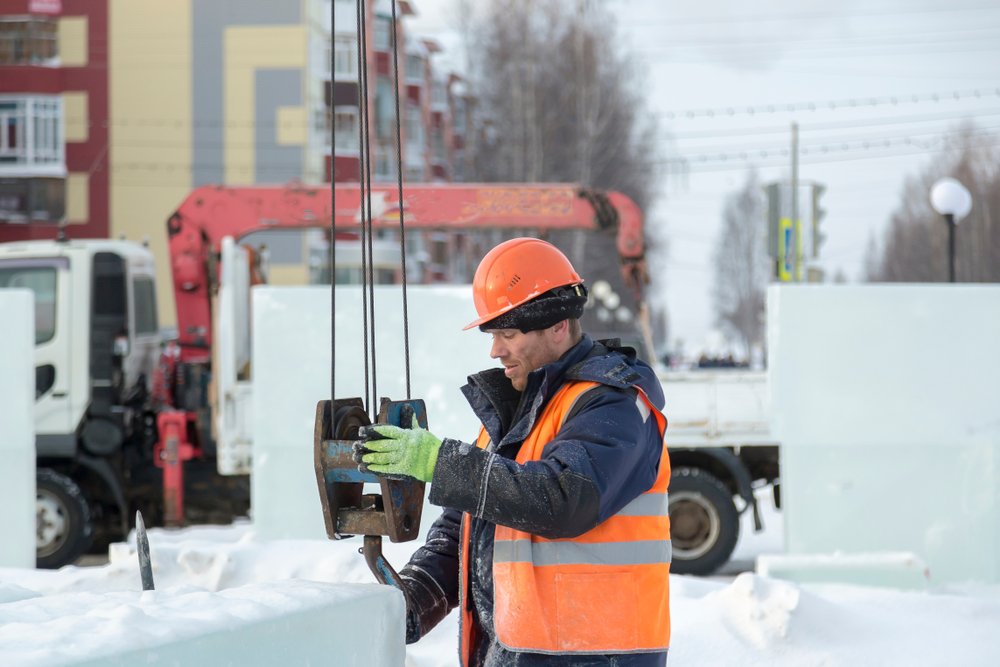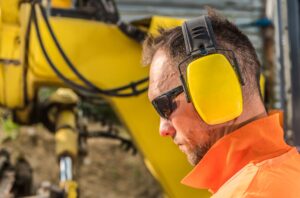12/20/2022—As winter rolls through, jobsites from construction to renewable energy must adjust for safety. The cold carries dangers with snow, sleet and ice in work areas, increasing the risk of slip and falls, exposure-related ailments, and new machinery maintenance protocols. In 2017 alone there were over 20,000 occupational injuries related to ice, sleet and snow, according to the U.S. Bureau of Labor Statistics (BLS).1 Lost-time injuries and illnesses resulting from “environmental cold” spiked nearly 142% in 2018 – soaring to 290 cases from 120 the previous year, according to the BLS.2 Compound that with year-round jobsite dangers, and it’s clear that heightened safety protocols are needed with the onslaught of winter.
Falls account for the highest number of jobsite injuries and fatalities, and with winter weather those numbers rise. The first step to winter fall prevention is removing ice and snow from work areas. In some cases, like active snow, areas may not be completely cleared and should be labeled. With site management like CoRe Connected Resources’ IoT-enabled platform, admins can set customizable zones equipped with entry alerts, which are helpful in areas of increased danger like snow-covered rooftops. If falls do occur, CoRe’s patented Personal Safety Device wearables (PSDs) are equipped with highly sensitive fall detection, alerting managers of slips and falls anywhere on multiple jobsites, including remote and underground.
Cold stress is a severe side effect of winter exposure. It occurs when external temperatures cause the internal body temperature to decline, leaving one unable to retain heat. Cold stress can manifest as hypothermia, frost bite or trench foot among other things, and can lead to permanent tissue damage or death.3 Educate your workforce on the signs of cold stress, including red skin, numbness, tingling or swelling in the extremities, uncontrollable shivering, slurred speech, inhibited movement, and loss of consciousness. CoRe even allows you to track employee trainings on such things via individual worker profiles.
Proper attire is essential to cold stress prevention. The Centers for Disease Control and Prevention (CDC) recommends multiple layers of loose-fitting clothing, waterproof jackets as a final layer, waterproof work boots and insulated gloves, along with headgear including personal protective equipment (PPE) and additional insulation needed to retain warmth. Employing the buddy system, where each worker is assigned a partner in order to monitor for cold stress throughout shifts, is another helpful step that can be tracked via IoT wearables like PSDs. Employers can ensure each worker is never without a partner using real-time site views.
Providing routine breaks in warm areas with hot beverages is also vital to preventing cold stress. Allowing employees to warm up throughout their shifts and ensuring workers are not in the cold for dangerous amounts of time is easy to maintain with IoT wearables like the CoRe PSD. Using PSDs, management can monitor hours worked and ensure break periods are staggered properly.
Don’t forget to protect and maintain all machinery during cold weather months too! The winter elements can cause greater stress on machinery and lead to breakdowns. It is recommended that to confer with manufacturer recommendations for winter usage and maintenance and act accordingly. “Owners of fleets of any size will benefit by establishing a written winter maintenance program,” said said Norty Turner, senior VP of Services & Advanced Solutions, United Rentals. “Identify the intervals equipment needs to be serviced and incorporate advanced planning to order parts and knowledge of when equipment will not be on a worksite.” CoRe’s IoT management platform is equipped with asset trackers that allow management to monitor machine usage, including idle times, and plan for needed maintenance. Asset trackers also track where equipment is used, on the road, underground or on surface sites, thus should accidents or breakdowns occur, assistance can be dispatched immediately.
Protecting employees from the blistery winter elements, and maintaining machine investments, is easier than ever with the help of technological innovations like CoRe’s Connected Resources platform. With CoRe you can carry your workforce through the harsh winter months and keep them safe through summer too. Contact us today to learn more!
…
¹ David PerecmanFeb 11, 2020. (n.d.). Cold and winter weather-related workplace injuries and tips to prevent them. Occupational Health & Safety. Retrieved December 20, 2022, from https://ohsonline.com/Articles/2020/02/11/Cold-and-Winter-WeatherRelated-Workplace-Injuries-and-Tips-to-Prevent-Them.aspx?Page=1%C2%A0
² Ferguson, A. (2022, January 24). Working in the cold. Safety+Health. Retrieved December 20, 2022, from https://www.safetyandhealthmagazine.com/articles/20522-working-in-the-cold%C2%A0
³ Department of Labor Logo United States Department of Labor. Winter Weather – Cold Stress | Occupational Safety and Health Administration. (n.d.). Retrieved December 20, 2022, from https://www.osha.gov/winter-weather/cold-stress
Copeland, A. (2021, April 13). Winter Safety Stats. Safety Reports | EHS Safety Management. Retrieved December 20, 2022, from https://www.safety-reports.com/blog/winter-safety-stats/
Authors, C. E. C. (2021, December 10). Tips to keep equipment running in cold from United Rentals. Compact Equipment Magazine. Retrieved December 20, 2022, from https://compactequip.com /business/tips-to-keep-equipment-running-in-cold-weather-from-united-rentals/





